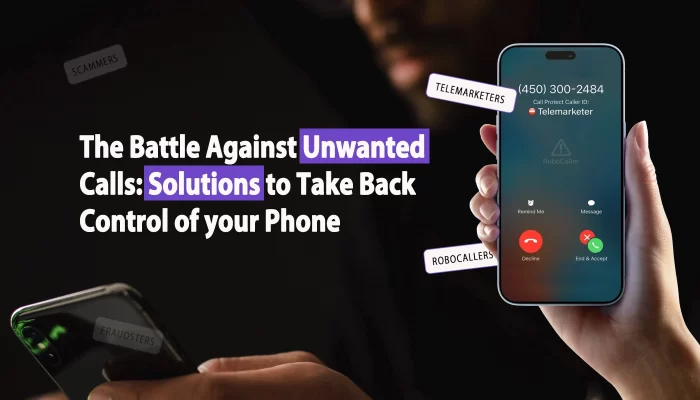Unwanted Calls: Understanding the Problem and Finding Solutions

Are you tired of constantly being interrupted by unwanted calls and telemarketers?
Unwanted calls can be a major annoyance and source of stress for many people. Whether it’s telemarketers trying to sell you something or scammers trying to steal your personal information, these calls can be disruptive, overwhelming, and can make it difficult to know who is on the other end of the line.
The good news is that there are steps you can take to reduce the number of unwanted calls you receive and protect yourself from scams and telemarketers.
In this article, we’ll take a closer look at unwanted calls, the sources of these calls, how spammers get your phone number, and what you can do to reduce the number of unwanted calls you receive.
Understanding the Problem
Unwanted calls come in many forms and can be made for a variety of reasons. Some of the most common sources of unwanted calls include telemarketers, scammers, and robocalls.
Telemarketers use automated dialing systems to make sales pitches and offer products and services. These calls can be especially annoying if they are made during dinner or other inconvenient times. Telemarketers are often required to abide by the National Do Not Call Registry, but many still make calls to those on the list, hoping to catch them off guard.
Scammers also make unwanted calls in an attempt to trick people into giving them personal information or money. They may claim to be from the government or a reputable organization, such as the IRS, and ask for personal information, such as Social Security numbers or bank account information. Scammers may also offer a prize or ask for money in exchange for a service.
Robocalls, also known as automated calls, are computer-generated calls that deliver pre-recorded messages. These calls can be used for a variety of purposes, including political campaigns, surveys, and debt collection. Robocalls can be especially annoying because they are often made in large numbers and can be difficult to block.
How Spammers Get Your Phone Number
Spammers are able to obtain your phone number in several ways, including public records, data breaches, and other forms of data collection. Public records, such as those obtained from the White Pages or other online directories, can be accessed by anyone and include personal information, including phone numbers. Data breaches can occur when sensitive information, such as your phone number, is stolen from a company or organization. This information can then be sold or traded on the black market, making it easy for spammers to obtain it.
In addition to public records and data breaches, spammers can also obtain your phone number through contests and sweepstakes. When you enter a contest or sweepstakes, you may be required to provide personal information, including your phone number. This information can then be used for telemarketing or other purposes.
Another way spammers can obtain your phone number is through automated dialing systems. These systems allow spammers to call large numbers of people at once and can even mimic local phone numbers to make it appear as if the call is coming from a trusted source. This makes it difficult for people to identify the call as spam and can lead to them answering the call and providing personal information.
Spammers may also use a technique known as “spoofing” to make it appear as if the call is coming from a different number than it actually is. This makes it difficult for people to block the call, as they may not know the true source of the call.
Finding Solutions
The good news is that there are steps you can take to reduce the number of unwanted calls you receive and protect yourself from scams and telemarketers.
- Add your number to the National Do Not Call Registry: The National Do Not Call Registry is a free service that allows you to add your phone number to a list of numbers that telemarketers are not allowed to call. While this won’t stop all unwanted calls, it will reduce the number of telemarketing calls you receive.
- Use call-blocking technology: Many phone companies offer call-blocking technology that can help reduce the number of unwanted calls you receive. This technology can block calls from known telemarketers, scammers, and robocallers.
- Be cautious with personal information: Be careful about providing personal information over the phone. Scammers often ask for personal information, such as Social Security numbers or bank account information, in an attempt to steal your identity.
- Report unwanted calls: If you receive an unwanted call, report it to the Federal Trade Commission (FTC) or your phone company. This will help them track the call and take action against the caller.
- Download a call-blocking app: There are many call-blocking apps available for smartphones that can help reduce the number of unwanted calls you receive. Some of these apps are free, while others require a fee.
Best Apps for Blocking Unwanted Calls
- Call Protect: Call Protect is a free app that identifies and blocks unwanted calls. It uses a database of known spam numbers to help you avoid unwanted calls. The only downside is that this app is only available for iPhone users.
- Reverse Lookup: Reverse Lookup is another free app that allows you to block specific phone numbers or range of numbers. It also allows you to report spam numbers to help improve its database. It is available in both Apple App Store & Google Play Store.
- Call Blocker: Call Blocker is a paid app that allows you to block unwanted calls and texts. It also provides features such as whitelisting and blacklisting, so you can control which calls you receive.
Unwanted calls can be a major annoyance and can disrupt your daily life. However, there are steps you can take to reduce the number of unwanted calls you receive and protect yourself from scams and telemarketers. By adding your number to the National Do Not Call Registry, using call-blocking technology, being cautious with personal information, reporting unwanted calls, and downloading a call-blocking app, you can take control of your phone and reduce the number of unwanted calls you receive.
It’s important to stay vigilant and stay informed about the latest tactics used by scammers and telemarketers. By being proactive and taking the steps outlined above, you can minimize the impact of unwanted calls on your daily life and protect yourself from potential scams and fraud.
In conclusion, unwanted calls are a major problem for many people, but there are solutions available to help reduce the number of unwanted calls you receive. By being informed and taking action, you can take control of your phone and reduce the impact of unwanted calls on your daily life.




Comments 0